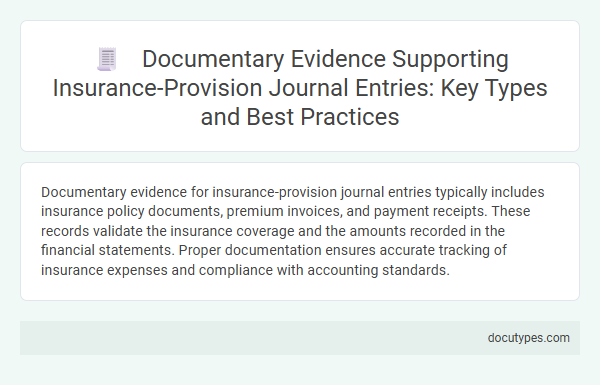Documentary evidence for insurance-provision journal entries typically includes insurance policy documents, premium invoices, and payment receipts. These records validate the insurance coverage and the amounts recorded in the financial statements. Proper documentation ensures accurate tracking of insurance expenses and compliance with accounting standards.
Introduction to Documentary Evidence in Insurance-Provision Entries
What constitutes documentary evidence for insurance-provision journal entries? Documentary evidence includes all relevant documents that support the recognition and measurement of insurance provisions in accounting records. These documents ensure accuracy and compliance with accounting standards in your insurance transactions.
Importance of Supporting Documentation for Journal Entries
Documentary evidence for insurance-provision journal entries ensures accuracy and compliance in financial reporting. Such evidence verifies the legitimacy of transactions and supports audit trails.
- Proof of Insurance Policy - Documentation like policy contracts confirms the terms and coverage details used in journal entries.
- Payment Receipts - Receipts or invoices validate the amounts provisioned and paid for insurance premiums or claims.
- Claim Reports - Detailed claim documents substantiate expense recognition and provision adjustments related to insurance claims.
Key Types of Documentary Evidence in Insurance Accounting
Documentary evidence for insurance-provision journal entries includes essential records that validate the recognition and measurement of insurance liabilities. Key types of documentary evidence in insurance accounting consist of policy contracts, claim reports, and actuarial valuation reports. You must ensure these documents are accurate and complete to support the financial statements and comply with regulatory requirements.
Policy Contracts and Coverage Schedules as Primary Evidence
Documentary evidence for insurance-provision journal entries is essential for validating financial records related to insurance policies. Policy contracts and coverage schedules serve as the primary documentation to confirm the terms and extent of coverage.
- Policy Contracts - These legal documents outline the insurance agreement between the insurer and the insured, providing detailed terms and conditions necessary for journal entries.
- Coverage Schedules - These schedules specify the types of coverage, limits, and effective dates, supporting the accurate recording of insurance provisions.
- Audit Trail Support - Policy contracts and coverage schedules create a reliable audit trail for verifying the legitimacy and accuracy of insurance-related financial entries.
Premium Payment Records and Reconciliation Statements
Documentary evidence for insurance-provision journal entries is essential for accurate financial reporting and audit compliance. Premium payment records and reconciliation statements serve as primary proof for these accounting transactions.
- Premium Payment Records - These documents confirm the actual payment of insurance premiums, detailing amounts, dates, and policy information.
- Reconciliation Statements - These statements verify that journal entries align with the insurer's ledger and bank records, ensuring accuracy.
- Audit Trail Purpose - Both records establish a clear audit trail that supports the validity of insurance expense recognition and provision adjustments.
Maintaining organized and detailed documentary evidence facilitates transparent financial management and regulatory compliance in insurance accounting.
Loss Adjustment Documentation and Claims Settlement Reports
| Documentary Evidence | Description | Role in Insurance-Provision Journal Entries |
|---|---|---|
| Loss Adjustment Documentation | Detailed records maintained by insurance adjusters, including estimates of damages, repair costs, and loss assessments related to insured events. | Provides the basis for quantifying the liability and establishing the insurance provision amount in the accounting records. Adjusting entries reflect estimated settlement costs derived from this documentation. |
| Claims Settlement Reports | Official reports summarizing the resolution of insurance claims, including authorized payment amounts, claim approvals, and settlement timelines. | Validates the final settlement values that inform the journal entries for clearing provisions or recognizing expenses. Supports accuracy in financial statements by confirming actual claim payouts. |
Actuarial Reports and Reserve Calculation Worksheets
Documentary evidence for insurance-provision journal entries primarily includes actuarial reports and reserve calculation worksheets. These documents provide the necessary data and calculations to support the recognition and measurement of insurance reserves.
Actuarial reports contain expert evaluations of policyholder liabilities and claim projections based on statistical models. Reserve calculation worksheets detail the step-by-step computation of reserve amounts, ensuring accurate journal entries reflect the insurer's financial obligations.
Regulatory Compliance Documentation and External Audits
Documentary evidence for insurance-provision journal entries primarily includes regulatory compliance documentation required by insurance authorities to ensure accurate financial reporting. These documents validate the adherence to statutory provisions and confirm the correct calculation of insurance liabilities.
External audits play a critical role by verifying the authenticity and completeness of insurance-provision records through detailed examination of policies and claims data. Auditors rely on regulatory filings, actuarial reports, and reconciliation statements to substantiate the journal entries made for insurance provisions.
Best Practices for Organizing and Storing Evidence
Documentary evidence for insurance-provision journal entries includes policy agreements, claim forms, and payment receipts. Proper documentation ensures accuracy and compliance in financial reporting for insurance provisions.
Best practices for organizing and storing this evidence involve maintaining a centralized digital repository with secure access controls. Documents should be categorized by policy type and date to facilitate quick retrieval during audits or reviews. Regular backups and adherence to data privacy regulations are essential to protect sensitive information.
What Is the Documentary Evidence for Insurance-Provision Journal Entries? Infographic

